Did you know that Guide Dogs and dogs in training are legally permitted to accompany their handlers just about anywhere in Australia? This International Guide Dog Day (29 April 2015), Guide Dogs Victoria released research revealing that almost two thirds of Victorian Guide Dog handlers experience discrimination on a regular basis because of their Guide Dog companion.
The City Lane was invited to spend some time with Guide Dogs Victoria in the lead up to International Guide Dog Day, walking around Melbourne’s CBD with Guide Dog client David and his Labrador Oliver and Guide Dog trainer Eddie and trainee Labrador Warren. As dog lovers, and believers in equality for all, we couldn’t pass up this opportunity.
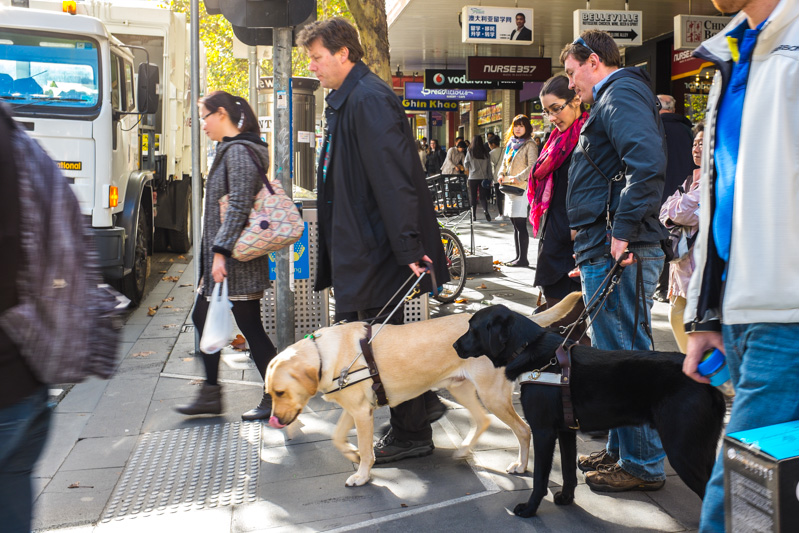
Eddie is a trainer for Guide Dogs Victoria who is currently putting 16 month old Warren through his paces. This was Warren’s first time in the CBD so he was following the lead of veterans Oliver and David.
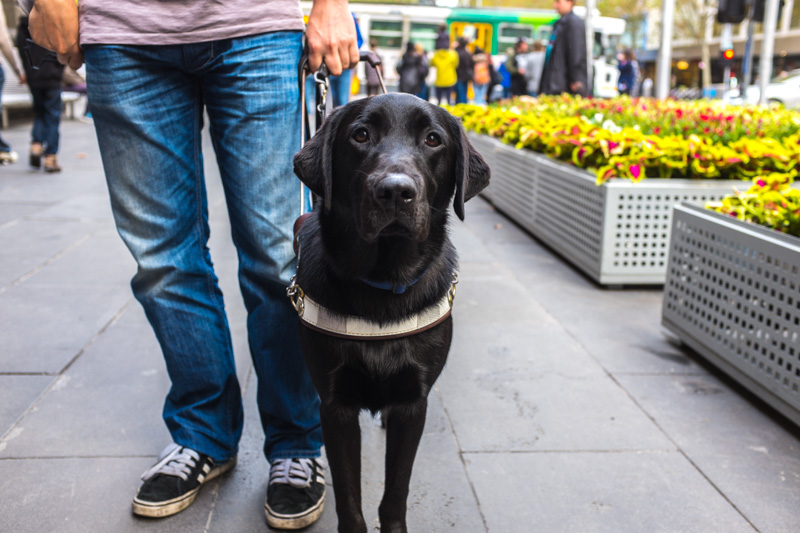
To start our time together, Eddie suggested we have a walk through the CBD, grab a coffee and blindfold Paul on the way back for some first hand experience. As we walked up Swanston Street, David explained some of the tools available to help visually impaired individuals with navigation around the built environment. One of these tools is the use of Tactile Paving, or Tactile Ground Surface Indicators. On footpaths throughout Melbourne are a series of oblong raised markers (Directional or Guidance Tactile) that guide visually impaired people along a route when the traditional cues, such as a property line or kerb edge, are not available.
As we approached an intersection these markers changed to raised dots which indicated a directional decision point. Until David mentioned these markers I was completely oblivious to that fact that this tool existed. There is a common misconception that Guide Dogs are “super dogs” that know where they are going and what to do however the reality is that the handler is an active participant in this relationship. David explained that these markers are tactical tools for the handler rather than the dog as not all the responsibility navigating lies with the Guide Dog. A Guide Dog’s job is to lead its handler to a curb and stop but it is the handler’s decision to cross the road. Whether or not it’s safe, the Guide Dog will follow its handler.
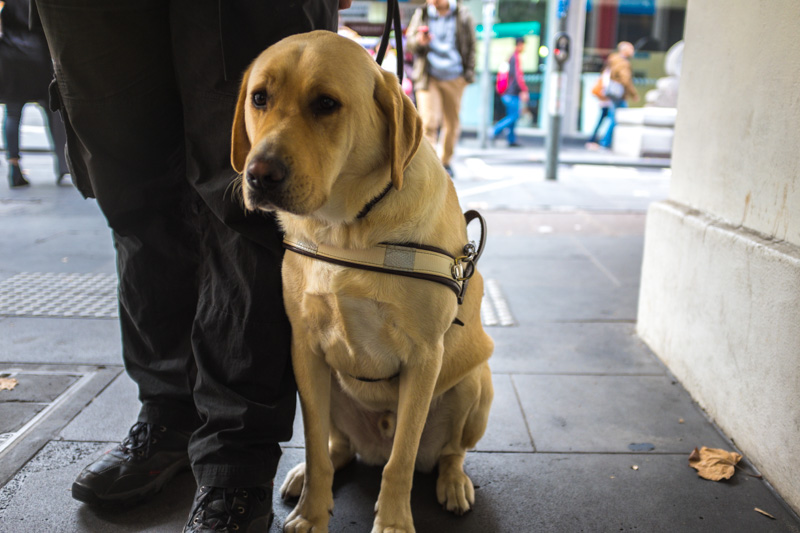
There is an incredible level of trust and a constant narrative between both parties to ensure that they can safely and easily get from point A to point B. A Guide Dog will remember a route that it has taken in the past and will automatically follow that route once again if in the same location. It is the handlers job however to let the dog know whether or not they are going to take that route or go in a different direction.
As we continued to walk, I inquired about the public’s attitude towards Guide Dogs and current hurdles for those with visual or mobility impairments. A key issue that was raised was accessibility to resources. There are numerous locations in Melbourne, or indeed any city, that are not accessible to those with such disabilities. For example a pathway may be too narrow or there may be an obstacle blocking access to a destination – these factors result in frustration and loss of independence for the individual.
David told us how the Disability (Access to Premises – Buildings) Standards 2010 (Cth) set in place new standards for building design to allow accessibility for all. To see these new standards in practice we decided to walk to Emporium Melbourne. As Melbourne’s newest shopping centre (it opened in 2014) we thought that it would be a great example of the new accessibility standards.
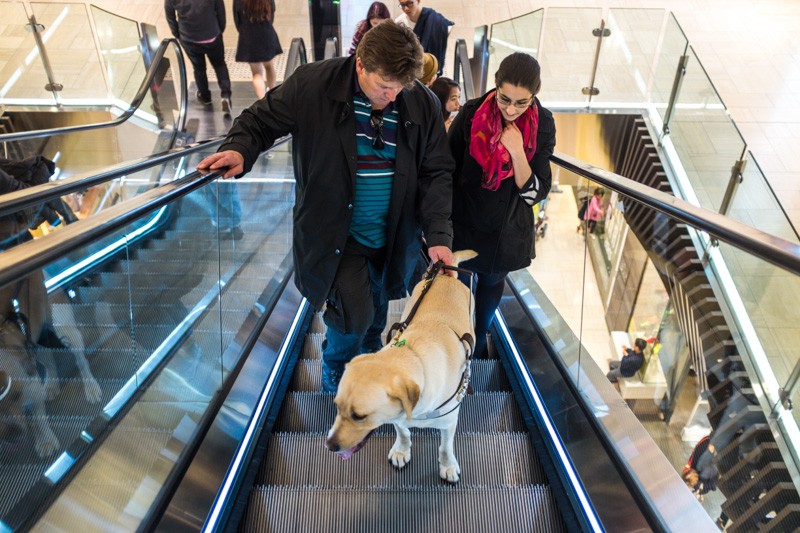
When I walk into a shopping centre I don’t pay attention to how wide an entry may be or where the information points are located, I just walk in and start browsing the shops. The situation for a visually impaired individual with a Guide Dog however is very different. David needs to consider if the door will be wide enough for both him and Oliver to walk through, he needs to think about the layout of a shopping centre in general, and take into consideration things like the location of lifts and escalators and where the information desk is located in order to ask for directions.
We walked through the large bright entry, past the touch screen information stand to a spacious area containing a manned information desk. At this point we stopped to observe the layout. The information desk was comprised of three high benches with one lower side. The requirement for an accessible desk and information counters formed part of the new building codes. This seemed like a relatively good start until we noticed a white couch situated close to the low bench. The placement of the couch was such that access to the counter for someone in a wheelchair was impossible, and for someone who was visually impaired with a guide dog, difficult. The reason for having a counter that adhered to the code was almost completely obviated by the placement of the couch.
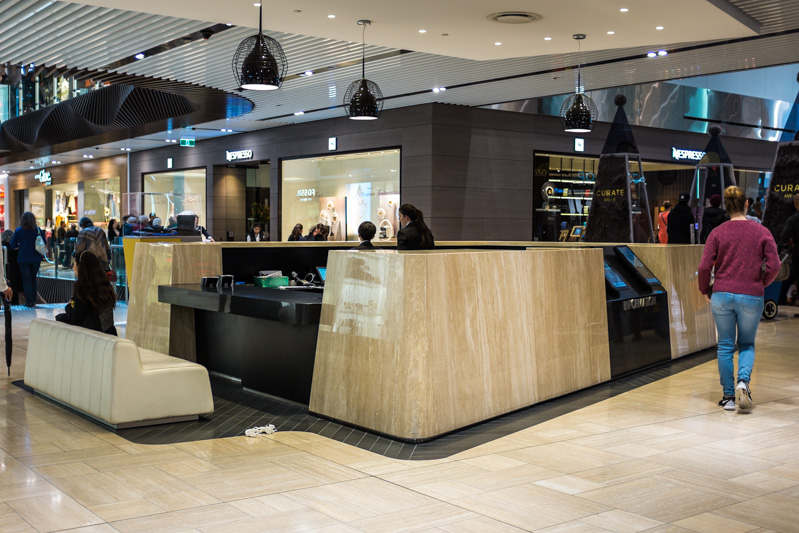
Next we decided to find the lift up to the 3rd floor food court as we all felt like a coffee and a sit down. As we stepped into the lift I noticed the buttons had raised numbers and Braille. David noted that this was a good example of adherence to code. When the button for the 3rd floor was pressed however, there was no audible indication as to which button had been pressed. When the lift reached the 3rd floor (and later on the ground floor when we went back down), the announcement that the floor had been reached was very quiet. We gradually made our way to the food hall, bought coffees and continued talking.
Food halls are generally areas that David and Oliver avoid. They are noisy which makes it difficult to orientate oneself, space is often tight and, as there is nobody around to assist, it’s difficult to find a suitable seat. David mentioned that if it was just Oliver and David, Oliver would generally lead David to the first available chair. This chair may be at a table with other people sitting at it which could result in an awkward situation.
As I listened to David discuss the sorts of things that he has to think about when entering a unfamiliar location, including the aforementioned accessibility issues, I was overcome by a sense of fear. In that moment I could in part understand just how easily one could feel helpless. This could deter a visually impaired or a disabled person from wanting to return to a location. Indeed David mentioned that despite Emporium Melbourne being one of Melbourne’s premiere shopping destinations, and stocking many things that he might be interested in, he’d be unlikely to return based on the day’s experience.
After hearing and seeing some of the issues faced by David in his day-to-day life it was time for Paul to be blindfolded and guided by Warren. Speaking to Paul about the experience the first thing he noticed was the unexpected speed of the movement. Although the pace with Warren wasn’t any faster than Paul would normally walk, being blindfolded instantly made things feel a lot faster. I also noticed that Paul was looking around a lot more than he usually does. The blindfold made him pay more attention to his other senses and his looking around despite not being able to see was him paying extra attention to everything that was going on around him.
Paul also mentioned that he was never really aware what direction he was going exactly. He knew that he was walking down Swanston Street towards Federation Square but he was very much relying on Warren to guide him around pedestrians and obstacles. Looking at Paul I could see him being guided around these things by Warren but speaking to him afterwards, it was interesting to note that he never really knew when he was manoeuvring around obstacles – he had to place his trust in Warren. Visual cues combined with audio cues – such as “follow” in conjunction with a sort of underarm bowling motion were crucial to this mutual relationship.
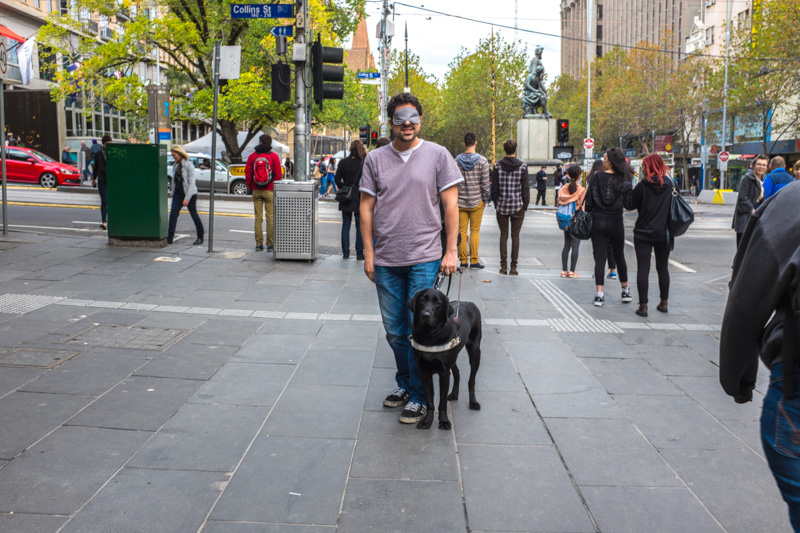
Finishing up for the day, Eddie told us about a few more challenges faced by visually impaired individuals with Guide Dogs. Accessibility is not the only challenged faced by Guide Dogs and their handlers – there are also problems regarding petting or feeding a working dog. The analogy we were given by David was a good one:
Having someone come up and massage a working Guide Dog is like having someone kick the wheels of a wheelchair.
Having a distracted dog can be very dangerous – it can be the difference between stopping at a red light or being hit by a car. This was evident at the end of our session when Warren had his harness removed and we were allowed to play with him. A couple approached us and started to ask questions about Warren and Oliver. Eddie explained to the couple that they could pat Warren but that a dog with a harness is working and it shouldn’t be interrupted . The man then tried to feed Warren a grape however this was quickly stopped.
Once the couple departed, I asked Eddie how often those kind of encounters occurred. His response was quite often. Education has improved over the years but many people still don’t full appreciate how important it is not to distract a working Guide Dog. Eddie gave us an example that occurs more often than it should, where people come up to a working Guide Dog and say something along the lines of “I know I shouldn’t pat him but he’s so cute and I can’t resist” and then proceed to pat the working dog anyway.
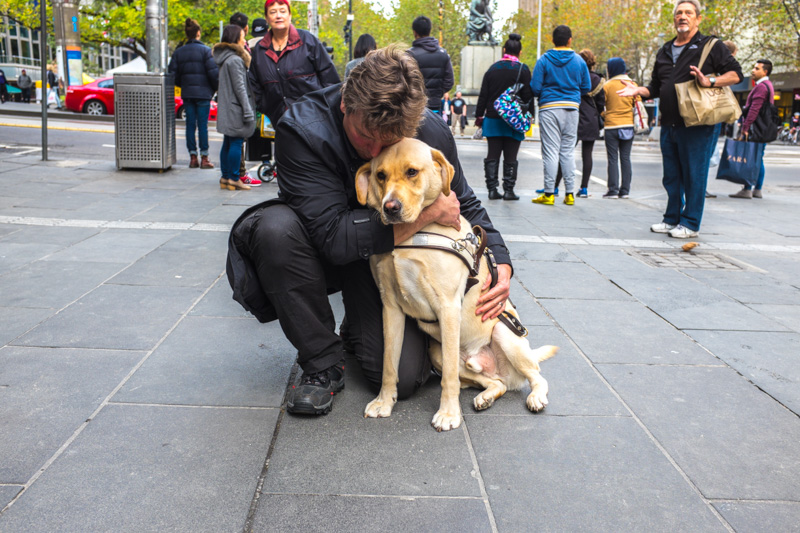
Other challenges discussed included being refused entry to cafes and taxis. As mentioned before, it really does come down to a lack of awareness. Other challenges that we hadn’t thought of were also raised by David and Eddie. What, for example, happens in the future if all cars on the road are electric and silent? What about the increased prevalence of cyclists, who are also silent and can often be unpredictable?
Paul and I learned a lot about the challenges faced by visually impaired people when it comes to something that most of us take for granted, like a weekend day out shopping and getting coffee in the CBD. There were a variety of things that we wouldn’t have even recognised as being issues until we were made aware of them, many more than we have covered even today. Thanks to Guide Dogs Victoria for giving us the opportunity to get the insight and thanks to David, Eddie, Oliver and Warren for taking the time out of their day to spend the afternoon with us. Hopefully those of you who are reading this have learned something new too.
Remember, by law a person who is blind or vision impaired accompanied by a Guide Dog is permitted to:
Travel on any form of public transport including taxis, buses, trams and trains (Guide Dogs are trained to sit quietly at their handler’s feet and will not disturb or lick the driver)
- Enter any public place
- Visit any theatre
- Eat in any restaurant
- Shop in any store (including supermarkets and food stores)
It is generally discriminatory and unlawful for anyone to attempt to deny these rights to a blind or vision impaired person solely because he or she is accompanied by a Guide Dog or to treat a person with a vision impairment less favourably because of the fact they possess or are accompanied by a Guide Dog.
If you’re interested in learning more about Guide Dogs, we highly recommend you visit the Guide Dogs Victoria homepage, where you can find a wealth of information around what the organisation does, accessibility issues, services offered, vision impairment and a whole lot more. In closing thought, let us leave you with this quick list of key points around Guide Dog etiquette.
- The Guide Dog must not be the centre of attention. Please don’t pat, feed or otherwise distract the dog when it is working. A well-intentioned pat can undo months of training.
- Please don’t grab the person or the dog’s harness. First ask if they need assistance.
- When you provide guiding assistance, please walk on the person’s opposite side to the Guide Dog.
- Please make sure your pet dog is on a leash or under control around a Guide Dog. When approaching, it may be polite to let the person know that you have a dog.
- If you see a loose dog, please contact the local council.
- According to government legislation, you must allow a Guide Dog to go anywhere that the person working with it can go.
- Guide Dogs are fully vaccinated and health checked regularly.

